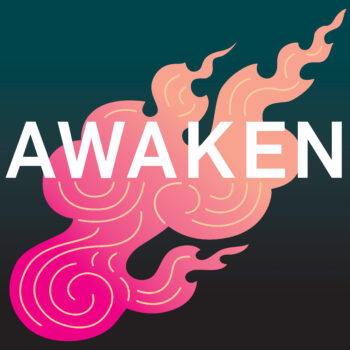
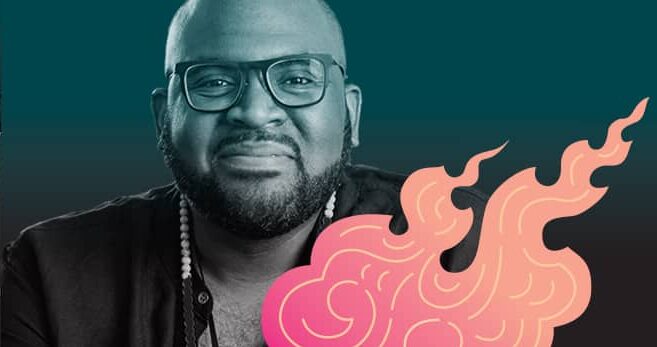
What is the ego, and what role might it play in the process of awakening? In this episode we ponder these questions with best-selling author, activist, and Buddhist teacher Lama Rod Owens, who shares his story of working through trauma, embracing pleasure, and both accepting and letting go of his ego.
LAMA ROD OWENS:
It’s not so easy to be free, you know, which is the contradiction. It’s an incredible amount of responsibility to be free. You’re not relying on being told what to do anymore. You’re not relying on boundaries that you’ve created to define the sense of ego, because the ego needs boundaries in order to figure out what it is. When those boundaries get blurred, then it gets real intense.
LAURIE ANDERSON:
Welcome to AWAKEN, a podcast presented by the Rubin Museum of art in New York City. That was the voice of Lama Rod Owens, and I am your host, Laurie Anderson. In this 10-part series, we explore the dynamic path to enlightenment and what it means to wake up. We’ll hear from authors, artists, wisdom bearers, and Buddhist teachers””people who have experienced a shift in their perspectives on life throughout their personal journey. This podcast is inspired by the exhibition Awaken: A Tibetan Buddhist Journey Toward Enlightenment, which illustrates the stages of enlightenment through paintings, sculptures, and other objects. We use these artworks as a jumping-off point to better understand the paths our guests have been on and where they are going. In this episode, we pondered the question: what is the ego? And what role does it play in the process of awakening? We speak with best-selling author, activist, and Buddhist teacher Lama Rod Owens, who shares his story of working through trauma, embracing pleasure, and letting go of his ego. Before we dive in, Lama Rod, responds to a ritual object called the Flaying Knife Chopper. This weapon is held by a fierce guardian whose purpose is to destroy not us but our egos. Here’s Lama Rod Owens, considering the knife.
LAMA ROD OWENS:
That’s a curved knife. The bottom of the knife looks like a half moon with a vajra handle. It’s ornate. It has Sanskrit writing on the blade itself. It’s a wrathful instrument, because it’s sharp. It can be construed as a weapon. There’s the energy of cutting, of slicing, of severing. So when I see instruments like this, this instrument is pointing me back to my body and the suffering of my body and the ways in which my body has been offered and given meaning, and that these instruments, these tools, are meant to bring me back to the reality of the physical body and all the stuff that I haven’t dealt with for my growing up.
So when you pick up this knife, you mean to enter into profound ritual, ceremonial work of cutting through ego. But more precisely it’s about cutting our fixation to ego by actually helping us to experience the expansive nature of the sense of self. We’re being sliced. We’re being offered. Those are the ways in which we enter into spaciousness, right? And it doesn’t get rid of the ego. It doesn’t bypass or repress the ego. It’s this deep, intuitive experience that everything is an inherent illusion . . . and that’s the freedom. The question that’s always at the beginning of everything for me is how can I be my most authentic self? And that’s just been, you know, the work of my life, like, who am I? I don’t have to call myself Buddhist or a teacher. I just talk about wisdom and clarity and compassion and love, but mostly how I practice these things in a way that’s real. And a way that’s helped me to survive a black queer body in this country. That’s where my Dharma comes from.
I grew up in the south and north Georgia. I’ve just recently relocated back to Atlanta, which is Muskogee, Cherokee, and Creek lands. And I grew up, of course, the Bible Belt, Deep South, you know, in church around a lot of religion. My mother is a minister. She’s still a minister. But I didn’t grow up in a conservative, fundamental household””very liberal, very progressive. I felt a lot of freedom to explore who and what I was. Right. And of course, there was still a lot of shame and still a lot of homophobia growing up. Absolutely. When I got into college, I just really started coming out more and more and really moving away from Christianity into a radical politic.
In my college years, I was involved in sexual assault advocacy work and HIV/AIDS awareness and education, working with people experiencing hunger and houselessness, and also really getting involved in queer rights and understanding what that meant. And I really felt like that was the path of liberation. I knew I had left Christianity formally and just really dedicated myself to the work of liberation. Of course, I wouldn’t use this word liberation, you know, back then, but that’s what I was trying to do. That was deeply informed by black radical politics as well. The black prophetic tradition, which I grew up with””and you’re reading and experiencing from others around me. I graduated and moved to Boston and joined the Catholic worker movement called Haley House. And that’s where I was exposed to like everything. And it was just like, ohhhh, this is the world. I was exposed to religious, spiritual traditions I had never been exposed to. I was exposed to ideas and beliefs. I had such an intimate education around socialism and anarchism, what it meant to be radical. You know, what it meant to really be an activist and organizer. My friends were drug dealers and sex workers and formerly incarcerated folks. And we were all working together for this common goal of like social liberation. There were Jews, and Hindus, and Catholics, and Christian science healers, and lots of Buddhists. And that’s where Buddhism really began to introduce itself to me.
After I realized that I was actually moving through clinical, severe depression, I really started to turn my mind towards meditation. Of course, Vajrayana was the tradition that I was surrounded by . . . like everyone I knew practiced Vajrayana, which was not coincidental because I needed something that would meet the intensity of my mind and my body and everything that I needed to work with. Something real, real, meaty, real complex, something that acknowledged the darkness as part of the path of freedom. So they just, they got me, they drew me in and early on I really believed and understood that my path was to become a teacher. So I eventually was able to connect to my monastery, which is just north of New York in Hudson Valley. I found my root teacher, Norlha Rinpoche. I was living in Boston, so I eventually relocated down to New York to move into the monastery and eventually entered into a three-year retreat.
Finishing three-year retreat, I was able to get a position as a resident teacher in DC at one of our affiliate centers, Kagyu DC. Of course, that was after retreat, this is 2012, 2013. And this was Trayvon Martin, this is the beginning of the movement for Black lives. And so that really began to call me back into activism, but I was being called back as a teacher. And so my question was: What is my role as a Dharma teacher now in movements of liberation? That gave rise to Radical Dharma with Reverend angel Kyodo williams and Jasmine Syedullah,, and we published Radical Dharma. That really helped me to form this identity of who and what I was. And as someone who was Black, and beginning to be a public figure in a tradition where there hadn’t been a lot of people of African and Black descent, I really began to feel the anti-Blackness of the tradition, and also felt the anti-queerness as well of the tradition.
And I really started making decisions to identify in a way that was much more in line with an ethic that I could create around the reduction of harm. So I started identifying more as a tantric teacher, and that helped me to also embrace my practices within Vedic-Hindu traditions. So they helped me to create the space to honor my wall of Kali and Genesh and yoga traditions along with these kinds of Vajrayana practices and deities and pantheons that I loved being in a relationship with. I am also reconnecting to my indigenous practices. So both my indigenous practices in terms of like Native American practices, but also my indigenous African practices, the gods of my ancestors, the practices of my enslaved ancestors and Hoodoo and Ifa. Cause I think these energies are also very much a part of who and what I am.
So right now, it’s a coming together of many different things, but also this incredible experience of understanding the commonality of all these traditions I’m pulling from now and how these traditions have always been speaking to me. Like Buddhism has just been a doorway into understanding the complexity of both the seen and unseen world, right. You know, and that Buddhism isn’t the only path of liberation. There are many paths of liberation. That many traditions and cultures understand liberation in different ways, but all of these traditions, including Buddhism, just point us somewhere. And I trust in that pointing and trying to walk in that direction.
At the beginning, pleasure was problematic for me. I didn’t know how to relate to pleasure. I didn’t know how to relate to my body. I didn’t feel as if I deserved to experience pleasure because I felt like pleasure was reserved for people who were more attractive, who were slimmer, who were sexier. Pleasure was for””I would use the language of Vajrayana””it was for the gods. Pleasure was for the gods, in the gods’ realm. And I was like in the human realm. And so in the human realm it was just struggle, with suffering. But when I completed three-year retreat and received my authorization to teach, it really transformed my relationship to pleasure. I wasn’t ashamed of pleasure any longer. And I began to really understand how to express agency in pleasure.
That I don’t get lost in the pleasure of the erotic, of sex. Of course that has taken the work of creating a set of ethics that safeguards my pleasure and the pleasure of my partners in the moments. And all of that, it intensifies. Those ethics create boundaries for compassion to arise within the expression of sexuality and the erotic. Of course, pleasure as an energy is related to space. And space is a natural quality of our minds, which is to say that it’s also a natural quality of reality. So pleasure opens a door to that experience of deep spaciousness that holds everything. It doesn’t erase anything, right, but it holds everything. And I think that is the point of our practice is to get to a place where everything is being held and experienced.
Three years of renunciate and celibate was just this period of actually embodying sexuality and eroticism in a way that wasn’t getting distracted by sex and connectivity with others. Just this period of exploring, okay, what is this energy? Instead of just reacting to the energy, I just kind of set in the energy and kind of swam in it. And just kind of got really curious about what this was and how it was. Doing this incredible work of understanding, yes, and this is part of my body. Like I have to be, this energy has to lead me back into my body and it has to lead me back through the shame, and through the trauma that I carried around. After retreat, I really found myself for the first time in my life really understanding particularly what sex was, and that it was okay to be sexually active. And of course, with the boundaries and the ethic attached to that. Absolutely. But within those boundaries, there was a lot of uncharted territory.
And right now I’m kind of moving into another stage of my sexuality, where I’m being called to go much deeper into this energy. Cause there’s still stuff, right? There’s still shame. There’s still narratives still really deeply embedded in my body that I want to go deeper into and to heal as well. And I’m excited about that work, but it’s also just really daunting because part of me thinks I’m already enlightened. And so why do I have to keep doing this really intense grueling work of working through the trauma and the shame, but knowing that like these karmas are very deeply in our consciousness. I knew early on that practice was like peeling back layers of an onion. We’re peeling back continuously over and over and over and over again. Right. And each peeling back reveals another layer of work that we have to engage in, but if we’re really committed to freedom then this is something that we have to be okay with.
I think about the first time I really experienced anger. Like there was the first moment of awakening for me when I actually could feel anger as energy sensation in the body, and to feel the process of anger, becoming a mental experience of the mind and just seeing that and saying, oh, the secret has been revealed. I’m no longer bound to this illusion, this mystical process of an emotion. I see it very clearly. So my relationships with emotions are very different. I get them now. I understand them. I was in retreat and it was a moment where I didn’t get something that I asked for, you know. And then realizing that I didn’t get what I asked for was really triggered, but that triggering in a way like disrupted and short-circuited any kind of mechanism that kept me awake. It was like I was shoved out of my body in order to really feel or see, rather, feel and see what anger really was. And then I came back into my body and said, oh, that’s it, got it. Okay.
Anger is just energy. Anger is just like any emotion or thought really, it’s just energy. So what we’re trying to do is learn to have agency with and over this energy, so we can channel it towards awakening, so we can channel it towards benefiting. When we talk about anger, anger is a secondary emotion that arises from being hurt. Often our relationship to anger is a reaction, and often we just create more harm. But in the path, we’re trying to develop the practice of noticing and experiencing the anger in order to open up into the space, and the space gives us the opportunity to respond. When we respond, we can consciously use this energy to benefit people, to benefit ourselves. Right. Back to hurt, not to harm but to consciously say, oh, I’m going to do this because I see very clearly. So much of my work and life in general, but even before Dharma was trying to make sense of the hurts.
And because I spent so much time and energy making sense of the hurt, my anger wasn’t as intense. So that’s why so much of my work is rooted within the trauma and sadness and woundedness or brokenheartedness. As I often say, that’s helped me to have an easier relationship with anger. Being awake is actually about being in relationship to the rough edges and the messiness. It’s messy. And when you get awake it’s confusing because””wait! Isn’t it supposed to be clearer? No, actually you’re seeing the complexity of everything. And then you’re given the space to respond to complexity, not just react but to respond. So there’s a responsibility to being awake.
You know, in my practice, ego is this belief in the self-existing self. And the self-existing self is just a collection of impressions and narratives and ideas and thoughts. They get bundled together to create this sense of self. You know, there are all kinds of egos, collective egos, social media egos. This is the ego of white supremacy. There are queer egos. You know, it’s just the ways in which we construct senses of self, often based upon a particular identity, location, agenda that we have. But all of this is just about this grand ego that we’re experiencing. We would say, oh, what is I, who am I? Right? And that’s terrifying. That’s really terrifying to start questioning. It feels heavy. It feels draining. It feels constricting. It’s contraction. It’s when I shut down and get really tight. I’m getting tight around this idea of ego I think is trying to protect me.
And when we started turning our attention more into the space that’s actually holding ego, then it’s a terrifying experience for most of us, you know, because we have found comfort in the contraction and the constriction. But when we’re asked to embody the space, then we’re moving to a lot of discomfort. It’s not so easy to be free, you know, which is, that’s a contradiction. It’s an incredible amount of responsibility to be free. You’re not relying on being told what to do anymore. You’re not relying on being instructed. You’re not relying on the boundaries that you’ve created to define the sense of ego, because the ego needs boundaries in order to figure out what it is. It’s like, it needs a sense of this is who we are and that’s what that is. When those boundaries get blurred, then it gets real intense.
For me, my practice isn’t to necessarily unravel the ego or the cut through it. My practice is just to simply to see, you know, to understand that this larger picture that I’m identifying as is actually just a collection of smaller impressions and images and feelings, all kinds of stuff that gets stuck together. And I just want to know that. And not only do I want to know that, I want to embody that. And that is what opens again, this quality of space for me. And of course, that quality of space is the expression of freedom. Freedom isn’t erasing anything. Freedom is actually realizing that, oh, there’s like space for me to move around whoever I am. Right. But whoever I am, it’s just everything, actually it’s beyond. I am more than just this ego. I’m everything. I’m the space, you know, itself.
LAURIE ANDERSON:
Before we come to a close, Lama Rod shares a practice that has helped him move from the tightness of the ego to the expansiveness of awareness. He references the Buddhist meditation practice of metta or loving-kindness, and he gives it his own spin.
LAMA ROD OWENS:
What’s been really helpful for me is what we would call benefactor practices, which is within the tradition of loving-kindness practices or metta practice. But we need to feel supported and, and connected, right? We need to feel loved or cared for, you know, and that’s the basis of this traditional practice. But in benefactor practice, for me, it’s like just imagining all these beings who love me coming and sitting with me and loving me. And I just sit in and absorb that love, you know, that’s all that the practice is. But we also have to confront the ways in which we’re deeply traumatized by love. So the practice actually helps us to begin to negotiate these layers of woundedness as well. We need space to wake up, right? So we need the space, but it’s hard to have that space when we don’t feel cared for.
And this energy of care is what helps us just to feel not alone. It helps us to feel connected, to help us to feel that we belong to others, that we belong to communities. Because that’s a part of the space. Like we can’t feel isolated and expect to get free. We have to be connected because that’s the reality. We’re all connected. This interdependence is one of the laws of the relative. Like everything’s connected, right? And so love practices connect us. You’re just calling into your space all these beings who love you””teachers guides, deities spirits, the earth, even””and just sitting within this field of being carried.
LAURIE ANDERSON:
Thank you so much to Lama Rod Owens for sharing his story. We hope you enjoyed it. For more information about our guests and to see images of the artwork in this episode, visit RubinMuseum.org/awakenpod. If you’re hungry to continue the conversation, join us on Instagram @RubinMuseum. And if you’re enjoying this podcast, leave us a review. Wherever you listen to podcasts. Leaving us a review is one of the best ways to help this podcast reach more listeners like you.
AWAKEN is produced by the Rubin Museum of Art in collaboration with Sound Made Public, and I’m your host, Laurie Anderson. This podcast is supported by Barbara Bowman, the Ellen Bayard Wieden Foundation, the Prospect Hill foundation, Bob and Lois Baylis and public funds from the New York City Department of Cultural Affairs in partnership with the City Council. AWAKEN is sponsored by Tricycle: the Buddhist Review, a print and digital magazine dedicated to making Buddhist teachings broadly available. Music for AWAKEN was created by Blue Dot Sessions, Podington Bear, Tendinite and Siddhartha Corthus.
Join us next time as BJ Miller, hospice and palliative medicine physician and author delves into how the act of dying is truly living.
Thanks for listening.
Before we dive in, Lama Rod responds to a ritual object called the flaying knife-chopper. In Tibetan Buddhist art, this weapon is typically wielded by a fierce guardian deity who uses the tool to destroy not us but our egos. Read more about the episode’s guests below.
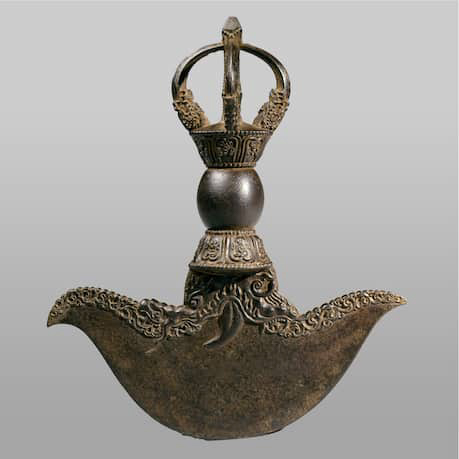
Flaying Knife-Chopper Tibet; 15th century Iron, clay The Newark Museum Purchase 1954, 54.350
The skull cup and the flaying knife-chopper are often paired in a wrathful deity’s opposing hands, and practitioners use them in rituals aimed to dismantle their ego. The blade of the knife is curved to match the skull’s cavity. Like a mortar and pestle, these ritual tools are used to reduce all the sense-based constituents of ordinary experience to their ultimate, empty nature. This physical and mental process purifies the wielder from negativities and any false conceptions of an independent, substantial self.
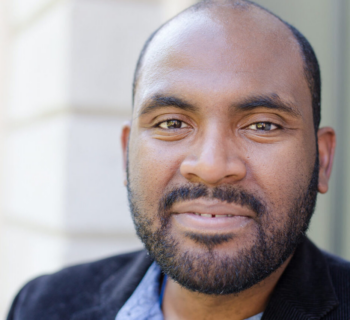
Lama Rod Owens is an author, activist, formally authorized Buddhist teacher, and graduate of Harvard Divinity School. He is the cofounder of Bhumisparsha, a Tantric Buddhist practice community as well as a co-author of Radical Dharma: Talking Race, Love, and Liberation. Love and Rage: The Path of Liberation through Anger was published in 2020.
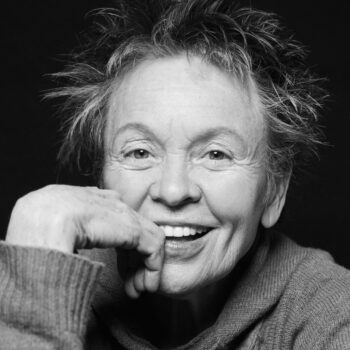
Laurie Anderson is one of America’s most renowned and daring creative pioneers. She is best known for her multimedia presentations and innovative use of technology. As writer, director, visual artist, and vocalist she has created groundbreaking works that span the worlds of art, theater, and experimental music. Ms. Anderson has published seven books, and her visual work has been presented in major museums around the world. In 2002 she was appointed the first artist-in-residence of NASA, which culminated in her 2004 touring solo performance The End of the Moon. Her film Heart of a Dog was chosen as an official selection of the 2015 Venice and Toronto Film Festivals and received a special screening at the Rubin Museum, where she joined in conversation with Darren Aronofsky. Ms. Anderson has made many appearances at the Rubin, and has been in conversation with Wim Wenders, Mark Morris, Janna Levin, Gavin Schmidt, Neil Gaiman, and Tiokasin Ghosthorse. She also hosted the premiere season of the Rubin’s AWAKEN podcast.
Get the latest news and stories from the Rubin, plus occasional information on how to support our work.